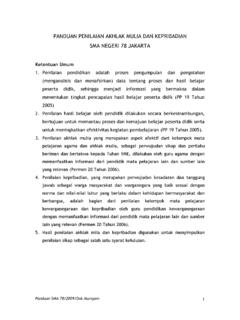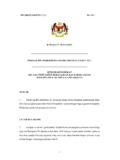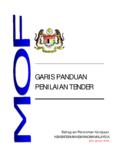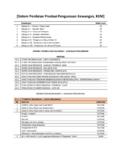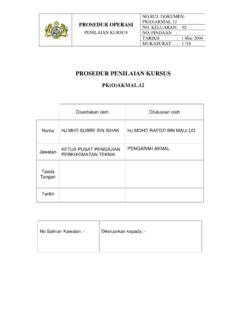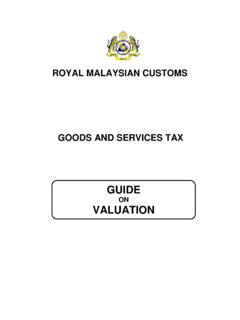Transcription of INDONESIA S PROGRAM FOR POLLUTION …
1 INDONESIA 'S PROGRAM FOR POLLUTION control , evaluation , and rating (PROPER)*. I. Abstract INDONESIA 's PROGRAM for POLLUTION control , evaluation , and rating (PROPER) is a national-level public environmental reporting initiative. The objective of this novel regulatory tool is to promote industrial compliance with POLLUTION control regulations, to facilitate and enforce the adoption of practices contributing to clean technology, and to ensure a better environmental management system. This PROGRAM is built on the premise that the mechanisms of public disclosure and accountability, transparency in operations, and community participation will empower local communities to achieve effective and sustained POLLUTION control practices.
2 The PROGRAM uses a color-coded rating, ranging from gold for excellent performance to black for poor performance, as well as reputational incentives. PROPER has had a significant effect in shifting factories from noncompliance to compliance. Over two years (June 1995 March 1997), the compliance level of the pilot PROGRAM factories, selected from the three river basins, increased from 35 percent to 51 percent. PROPER has also contributed to voluntary participation by factories in conducting compliance ratings and has increased awareness regarding environmental issues.
3 Additionally, PROPER helped promote an integrated control system of nongovernmental organizations (NGOs), local community groups, the Government of INDONESIA 's Environmental Impact Management Agency (BAPEDAL), and the media. Finally, PROPER exerted pressure on BAPEDAL to improve its rating methodology and refine its process to ensure that its ratings are trustworthy for initiating action against noncompliance. II. Background The PROGRAM for POLLUTION control , evaluation , and rating (PROPER) was an innovative attempt to mitigate the problems associated with POLLUTION under the umbrella of the Government of INDONESIA 's Environmental Impact Agency (BAPEDAL).
4 PROPER was launched in June 1995 with support from the World Bank, USAEP/USAID, and Canadian and Australian development agencies. The PROGRAM 's objective is to act as a regulatory mechanism which can promote and enforce compliance with POLLUTION control standards, encourage POLLUTION reduction, introduce the concept of clean technology, . and promote an environmental management system through the use of incentives and transparency. PROPER endeavors to raise awareness among people regarding waste management regulations, as well as encouraging business communities to comply with POLLUTION control standards.
5 The need for such an effort arose from INDONESIA 's inability to handle environmental crises because of industrial expansion and BAPEDAL's limited capacity in terms of monitoring and enforcement abilities. The success of programs prior to BAPEDAL, like ADIPURA (President's award for cleanest cities) and PROKASIH (wastewater *. This case study was prepared by Parameeta Kanungo and Mag i Moreno Torres at the World Bank (Washington DC). 1. Empowerment Case Studies: INDONESIA 's PROPER. management), gave significant credibility to the implementation of the environmental performance rating system operationalized as PROPER.
6 Public disclosure is key to PROPER's effort to control POLLUTION . PROPER's operations are not an alternative strategy to environmental regulation, but are aligned with the activities of JAGATIRTA. (regulatory monitoring and enforcement activity), ADIPURA, and PROKASIH. PROPER primarily targets companies and plants participating in PROKASIH. BAPEDAL's experience in handling water POLLUTION made PROKASIH participants (water polluters) the initial focus for the implementation of PROPER, which then widened its scope to include air and toxic POLLUTION .
7 In the pilot study conducted in early June 1995, BAPEDAL rated 187 plants, including medium- and large-scale polluters from several river basins on the islands of Sumatra, Java, and Kalimatan. By 1998, the PROGRAM expanded to cover 350 factories. There are currently 28 sectors and 14 provinces covered by PROPER A color-coded rating scheme was developed under PROPER to grade factories'. performance against the regulatory standards. The color coding system is based on five colors gold, green, blue, red, and black. These colors correspond to the different levels of performance in terms of POLLUTION control .
8 A gold rating is awarded to facilities that demonstrate excellent performance by going beyond the requirements of regulatory standards, and also by exhibiting similar results in control of air POLLUTION and hazardous waste. A green rating implies that the factories' environment management procedures go beyond the expected compliance level, while a blue rating signifies compliance with national regulatory standards. A red rating indicates a poor performance level, in which the factories display some sort of POLLUTION control effort but do not comply with the regulatory standards in absolute terms.
9 A black rating ranks lowest in the performance level. Factories are assigned a black rating if they do not make any attempt to control POLLUTION , thereby being major contributors to serious environmental risks. The policy objective associated with the gold and green ratings is encouragement of clean technology adoption while for blue, red and black ratings it is creation of a compelling force for compliance. The incentive associated with factories rated gold and green is public praise, which would enable them to gain a competitive edge in the market, whereas the deterrents for factories rated blue, red and black are public pressure and legal The public disclosure process incorporates three distinct steps: data collection and verification from different sources at the participating plants, data analysis, and assigning ratings with subsequent public disclosure.
10 The performance rating process includes the following steps: select the polluters;. gather data through mail surveys;. verify and inspect plants ;. develop a POLLUTION database;. analyze data at BAPEDAL;. 1. 2. 2. Empowerment Case Studies: INDONESIA 's PROPER. verify data at BAPEDAL;. obtain rating from the advisory board;. obtain rating approval from the Environment Minister;. report ratings to the President, and finally;. release the information to the This ensures that the data gathered goes through a process of rigorous scrutiny before it is released to the public since any error in rating would result in BAPEDAL losing its credibility.










